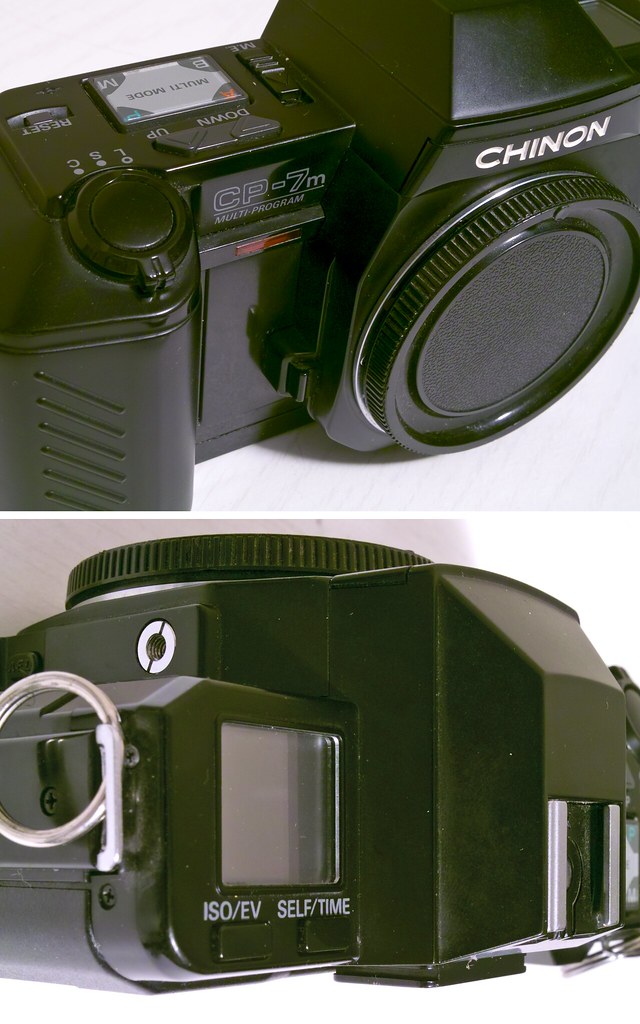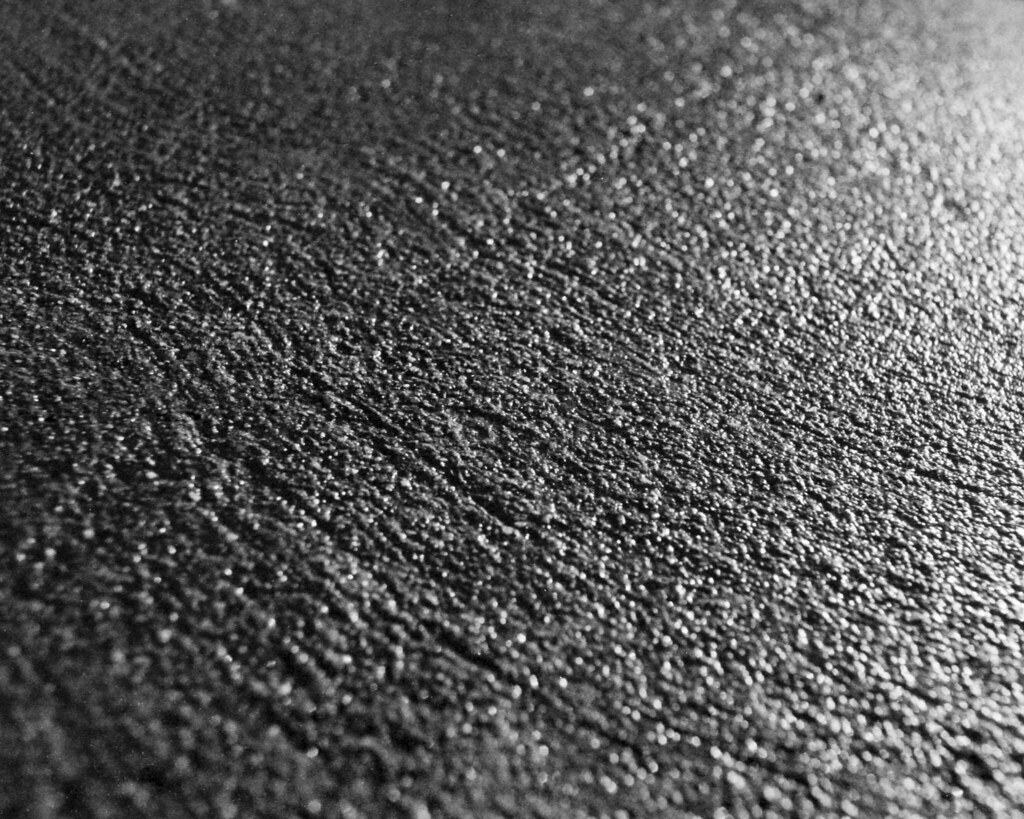Chinon CP-7m

This photo is part of my photo reference set on Flickr. Detailed notes accompany the photo itself.
Chinon was never one of the major players in the photography game, their name not as recognizable as Canon, Nikon, or Pentax. But they made some very interesting bodies throughout the years, including the CP-X, CP-5, CP-6, CP-5s, CP-7m, and CP-9AF. All of these have some neat features, and one very interesting trick up their sleeves — the ability to operate in program mode with any K-mount lenses (not just lenses with A settings — in fact, they tend to underexpose with A lenses due to a change in the K mount spec). While I’m still hoping to find a bargain on one of the first four CP cameras in the list above, this write-up will deal with the CP-7m. The CP-9AF is identical, except that it has electrical contacts to communicate with a couple of primitive auto-focus lenses from Chinon. The CP-9AF also provides electronic focus confirmation with manual focus lenses, auto-bracketing, and TTL flash (with dedicated Chinon flash units).
The CP-7m has one feature which I really hate — inbuilt motor drive. I’ve only owned two other SLRs with motor drive, and it annoyed me on both of them as well. I never shoot continuously, and even the quietest of motor drives are far louder and more irritating than a manual advance. Motor driven cameras also require more power, and are generally bulkier. For these reasons, the CP-7m could never be my go-to camera. But, to use a tired cliché, the CP-7m is a bit of a Swiss Army Knife, with plenty of niche features that will have me grabbing for it at the bottom of the camera pile every now and again.
The first neat thing, for a night shooter like myself, is how the camera handles bulb mode. Bulb has its own dedicated mode (there’s a four-way mode switch, much like the typical PASM, but without shutter priority and with bulb we actually have a PABM) which is a nice UI decision. Unlike a lot of cameras from the era of how-many-electronics-can-we-cram-into-this-body, the CP-7m takes a standard, old-fashioned cable release, and thus does not require a costly, hard-to-find, proprietary release — already a good start for long exposures. In the basic bulb mode, the display on the left-hand side keeps a count of the length of the exposure. This is shown in second intervals up until 60 seconds, and then minutes until 90 minutes. In fact, anything related to time follows the same scheme, which will come up several more times in this write-up, so make a mental note — everything time related can be done up to 90 minutes, with one-second precision up to a minute and one-minute precision after. While in minute display, the minute indicator on the display blinks every second. Unfortunately, the display is not backlit, so this counter may not be too incredibly helpful at night (the aforementioned CP-5, etc., beep every five seconds for the first minute, and every minute after in bulb mode, probably handier at night). Still, keeping track of bulb exposures seems like a no-brainer, though many cameras lack it.
Aside from normal, hold-down-the-release bulb mode, the CP-7m also offers what Chinon describes as a time mode. This isn’t the traditional time mode wherein the shutter is hit once to open and again to close. Rather, this is an extended bulb mode where you can tell the camera how long you want the shutter to be left open. This essentially means that if you don’t need to meter, your shutter speeds run from 1/2000 second to 90 minutes. Pretty exciting. While in this mode, the display counts down from your set time, and the exposure is cancelable at any time.

a six minute exposure using the bulb timer built into the cp-7m.
The self-timer has the same time range as the bulb modes. This, by itself, is kind of silly — an hour and a half self-timer has pretty limited utility. But the trick is this — set the motor drive to continuous, add a locking cable release, and you have a rather flexible intervalometer. Interval shooting was the one reason I almost held onto my Pentax PZ-1, though using the feature on the PZ-1 was much more of an ordeal than on the CP-7m. The only real issue with interval shooting on the CP-7m is that since it’s based on a self-timer, there is no initial shot. That is, the first frame to fire fires after the determined interval. For most short intervals this won’t matter, and for most long intervals a shot can simply be fired before switching to interval mode. Still, this could be an issue. Continuous (and therefore interval) mode works with the multiple exposure feature as well, so interval shots can all be performed on a single frame if so desired.

‘self portrait over the course of an hour’ achieved by leaving the chinon in multiple exposure mode, and shooting six frames at ten minute intervals.
The last thing that I really appreciate about this camera, even if it’s a pretty minor thing, is the power source. If you’re going to make me load a camera up with batteries, it’s nice to have options. And, the CP-7m gives me two options without even needing a stupid external grip — 1 pricy 2CR5 or 4 easy-to-come-by AAs. I tested the body with Sanyo Eneloops, and it does work perfectly fine with the 1.2V nominal output of NiMh cells.
Aside from all the little things that make this camera really stand out, it has some perfectly good specs. Speeds on the vertical-travel shutter range from 1/2000 to 8 seconds, and sync is 1/125. User interface is uncluttered and logical (although the buttons have a mushy feel about them). Tripod thread and lens mount are both metal, despite the camera being overall a bit plasticky. The back is removable in the normal manner, though the manual makes no mention of other available backs. The take-up catch has a similar release, though I haven’t actually found what it does. The camera operates without the back on, which could be useful for some DIY projects, I suppose. The finder is not half-bad, offering shutter speeds and metering through a bar of LEDs, though no display of aperture. Focus aids include a horizontal rangefinder split surrounded by a relatively fine microprism collar. Film speed is set via DX, with manual override available (32-5000 ISO). When DX-coded film is used, the ISO button turned into an EV± button, and the display keeps a persistent warning when anything other than ±0EV is set. The meter is of the wonderfully responsive silicon blue variety, and is center-weighted. Finally, AE lock is available via a small button to the right of the lens.
I loaded my CP-7m up with a half-roll of Kentmere 100, and plan to try some long exposures and interval shots in the coming weeks. Results will be posted here and on flickr.
Check out the Chinon group on Flickr. There’s also a nice group dedicated to K-mount cameras of all sorts.